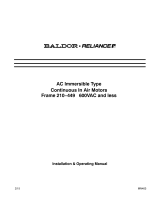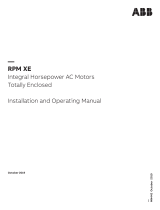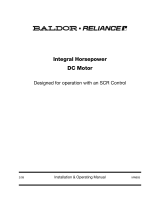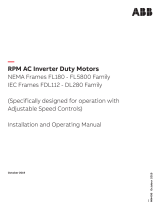Page is loading ...

1
WARNING: High voltage and rotating parts can cause serious
or fatal injury and property damage. The use of electrical
machinery, like all other utilization of concentrated power and
rotating equipment, can be hazardous. Installation, operation
and maintenance should be performed only by qualified
electrical and mechanical maintenance personnel familiar
with NEMA safety standards, the National Electrical Code and
sound local practices. The manual is to be studied thoroughly
by personnel responsible for the installation and maintenance
of this equipment before installation is begun. Personnel must
be familiar with the potential hazards involved. If this warning
is not observed, personal injury and/or property damage may
result. Keep this document for future reference.
GENERAL
Please read these instructions carefully. They contain vital
information on proper installation, operation, maintenance and
service for the Baldor gear reducer.
Each Baldor gear reducer is thoroughly inspected and tested at
the factory prior to shipment. Care is taken in packing of each
gear reducer. However, each gear reducer should be thoroughly
inspected before it is accepted from the transportation company.
If any of the goods called for in the bill of lading are damaged or
missing, do not accept the shipment until the freight agent makes
appropriate notation on your freight bill. If any loss or damage
is discovered later, notify the agent at once and request an
inspection. Though Baldor will be happy to assist you with claims
for loss or damage in shipment, the transportation company is
responsible for reimbursing you for such claims. Claims for loss
or damage in shipment must not be deducted from the Baldor
invoice, nor should payment of the Baldor invoice be withheld
awaiting claims adjustment. The carrier, not Baldor, guarantees
safe delivery. If considerable damage or shortage has occurred
and the situation is urgent, contact the nearest Baldor Sales
Ofce.
The Baldor reducer is warranted under the Baldor “Standard Terms
and Conditions of Sale”. Warranty claims must be submitted to
Baldor within one year from the date of installation or within three
years from the date of manufacture, whichever comes rst. The
warranty does not extend to failures induced by misuse, improper
storage or handling, abuse, or misapplication.
WARNING: Because of the possible danger to person(s) or property from
accidents which may result from the improper use of products, it is
important that correct procedures be followed. Products must be used
in accordance with the engineering information specified in the catalog.
Proper installation, maintenance and operation procedures must be
observed. The instructions in the instruction manuals must be followed.
Inspections should be made as necessary to assure safe operation under
prevailing conditions. Proper guards and other suitable safety devices or
procedures as may be desirable or as may be specified in safety codes
should be provided, and are neither provided by Baldor Electric Company
nor are the responsibility of Baldor Electric Company. This unit and its
associated equipment must be installed, adjusted and maintained by
qualified personnel who are familiar with the construction and operation
of all equipment in the system and the potential hazards involved. When
risk to persons or property may be involved, a holding device must be an
integral part of the driven equipment beyond the speed reducer output
shaft.
BALDOR IN-LINE HELICAL REDUCER
Sizes 38 thru 88
These instructions should be read thoroughly before installation or operation.
LUBRICATION OF THE BALDOR
ILH GEAR REDUCER
The Baldor gear reducer is factory lled with ISO 220 EP type
mineral oil to the correct oil level for the specied mounting
position. Changes in the mounting position will require
relocation of the oil level and vent plugs. Oil may have to be
added or drained to get to the correct oil level in the new mounting
position. See the Mounting Position Diagrams on Pages 2 and 3
for the correct plug locations for various mounting positions of
the Baldor reducer. The oil level should be checked before startup
and frequently thereafter, preferably with the unit at operating
temperature.
The Baldor gearbox is factory lled with lubricant. The factory ll
lubricant is suitable for use at all output speeds and in ambient
temperatures from +10°F to +105°F (-12°C to +41°C). No initial
oil change after break in is needed. The initial factory oil ll is good
for up to 10000 hours or 3 years of service, whichever comes rst,
in normal industrial environments.
Normal operating conditions are dened as steady loads not
exceeding normal ratings and running conditions as dened in
the Baldor catalog. Oil quantity and levels should be checked at
frequent intervals, depending on usage. Oil changes are required
after 10000 operating hours, or three years whichever comes
rst. The period can be extended to 20000 operating hours, or
six years, if a synthetic lubricant is used. The lubricant should
be changed more frequently if the unit is operating in a hostile
environment. In those mountings that require grease lubrication
for specic bearings, relubricate the affected bearings every
year, or every 2000 operating hours whichever comes rst. Use
a grease with a lithium complex thickener and ISO 220 viscosity
mineral oil base lubricant. Add 5 pumps of grease from a hand-
held grease gun.
Baldor reducers are shipped with lling, oil level and drain plugs
in place. A separate breather is included with the unit. Before
putting the unit into service the lling plug must be replaced with
the breather. HB38 and HF38 (1, 2 and 3 stage gear units) have
one oil plug, ventilation is not necessary.
NOTE: For ambient temperatures below -30°F (-34°C) special
oil seals are required. Consult Application Engineering.
Reference oil volumes for each Baldor gear reducer unit are listed
on page 3.

2
MOUNTING POSITIONS
IN LINE HELICAL C-FACE REDUCERS & SIZES 38-88
These mounting arrangements are for all output congurations and output shaft types. When ordering, please specify mounting
position for correct oil quantity. In cases of mounting position other than shown here with regard to the oil quantity, please contact
Application Engineering.
Oil level
Ventilation
Oil drain
A6
A4
A3
A2
Horizontal - Floor Mount
Horizontal - Wall Mount
Vertical Wall Mount - Motor Shaft Down
Horizontal - Wall Mount
Vertical Wall Mount - Motor Shaft Up
Horizontal - Ceiling Mount
QUANTIS
DODGE
*
QUANTIS
DODGE
*
*
QUANTIS
DODGE
QUANTIS
DODGE
*
QUANTIS
DODGE
*
QUANTIS
DODGE
*
A2
A1
A5
* On opposite side
HB38 and HF38 units are sealed and furnished with only one plug for the purpose of lling and draining.
Shaded mounting position not recommended. Use of product in positions not recommended negates the time-in-use warranty.
Figure 1 - Mounting Positions

3
Table 1 - Approximate Lubricant Amount
Type
Red.
Stage
Mounting Position
A1 A2 A3 A4 A5 A6
Pints Pints Pints Pints Pints Pints
H_38
2 1.1 2.5 1.3 1.5 1.3 1.3
3 1.1 2.3 1.3 1.9 1.3 1.9
H_48
2 2.3 5.1 3.2 3.8 3.4 2.7
3 2.3 5.1 3.2 4.9 3.2 3.0
H_68
2 3.8 8.7 5.3 6.8 5.7 4.9
3 3.6 8.5 5.5 8.5 5.5 5.1
H_88
2 8.7 18.6 12.0 15.9 12.9 11.2
3 8.5 18.8 12.5 19.7 12.5 11.4
NOTE: Do not mix oils from different manufacturers. If a change
to another type or brand of oil is made, the existing lubricant
should be drained and the gearcase ushed with a small quantity
of the new lubricant before relling with the new lubricant. This
is necessary to avoid possible incompatibility problems between
the two lubricants. The list below gives approved alternative
lubricants. This is not an exclusive list. Equivalent lubricants from
other manufacturers may be used.
Table 2 - Lubricant Selection Table
Ambient
Temperature*
Oil Type
ISO
Viscosity
Grade
Examples of Lubricants
Mobil
10°F to 105°F
(-12°C to 41°C)
Mineral Oil 220
Mobilgear 600 XP
220
0° F to 70° F
(-18° C to 21° C)
Mineral Oil 100
Mobilgear 600 XP
100
-10° F to 115° F
(-23° C to 46° C)
Synthetic Oil 220 Mobil SHC 630**
Other brand recommendations are available upon request. For
assistance contact Application Engineering.
*Ambient temperatures listed are for lubricant only and do not
indicate a particular gear unit’s suitability to run in that ambient.
Recommendations will be made based on specic application
details.
** Requires Vinton Seals
LONG TERM STORAGE
NOTE: Unless an extended warranty has been negotiated
prior to sale, time in storage is considered time in service for
warranty purposes.
If the drive is not installed immediately, it should be stored in a
clean, dry, protected area. During periods of long term storage
(six months or longer) special procedures must be followed. The
unit should be lled to the highest oil level hole with an approved
lubricant blended with 2%, by volume, of “Daubert Chemical Co.
Nox-Rust VCI-105” oil. Apply a thick coating of rust preventative
on all unpainted surfaces including threads, bores, keyways,
and shafts. Apply a thick coating of chassis-type grease to all
exposed shaft seals. If the unit is to be stored outdoors or in a
damp, unheated area indoors, cover the entire exterior with a
rust preventative. Seal the unit in a moisture proof container or
wrapping with a desiccant inside. Shade the enclosure from direct
sunlight. Rotate the input shaft at least 60 revolutions once a month
to redistribute the lubricant and prevent brinnelling of bearings and
drying of seals.
Upon removal from storage, remove all protective coatings applied
for protection during storage. Check all hardware for proper
tightness. Drain and rell the gear reducer with a recommended
lubricant. If the gear reducer has been stored for more than three
years or in an area with high ambient temperatures, replace the
oil seals.

4
1 Reducer Coupling Hub
2 Coupling Element
3 Motor Coupling Hub
X = Distance from motor
shaft end to end face of
coupling half (the length of
the coupling jaws is not
included in dimension X).
1
2
3
X
Figure 2 - Three-Piece Coupling Assembly
2 Reducer Input Bore
1 Clamp Collar
Figure 3 - Clamp Collar Assembly
Figure 4 - Clamp Collar Motor Key Fit
Bottom of Key
Correct key fit in Motor Keyway
Incorrect key fit in Motor Keyway
INSTALLATION AND OPERATION
Baldor reducers are shipped with ll, oil level and drain plugs in
place. A separate breather is included with the unit. Before putting
the unit into service the lling plug must be replaced with the
breather. Install the oil level plug and breather plug in the correct
location for the appropriate mounting position using the mounting
position diagrams shown on pages 2 and 3. Add or drain oil to get
to the correct oil level for the mounting position used.
Review the dataplates on the reducer and drive motor to verify
that the drive is correct for the intended loads, speeds and power
supply. The gear reducer should be installed in a location that
meets the following requirements:
• Ambient temperatures below 100°F (40°C).
• Free ow of air around the motor.
• Good access to gear reducer and motor for maintenance.
• A at, level, rigid steel mounting surface.
• All four feet of the foot-mounted unit must be evenly
supported.
• The ange mounted unit must have even support at the
ange face.
• Units supported by both ange and feet must be shimmed to
avoid housing stress.
• Good alignment to both input and output devices.
INSTALLATION OF COMPONENTS ON GEAR
REDUCER SHAFTS
Use care when installing couplings, sprockets and sheaves (pulleys)
on the Baldor input and output shafts. Such components should
not be hammered into place. Damage to shafts and bearings may
result. If parts do not slip into place easily, check for dirt or burrs
that may be binding the assembly. Very tightly tted parts may
need to be heated to get them onto the shafts. Keys should be
located for maximum engagement between the shaft and the
associated part. Sprockets and sheaves should be mounted as
close to the gearcase as possible to minimize overhung loads.
Retaining hardware (setscrews, etc.) for couplings, sprockets
and sheaves should be tightened as recommended by the
component manufacturer. Chain and belt drives must be aligned
to run true. Tighten chains and belts according to the chain or
belt manufacturer’s instructions. Excessive tension results in rapid
chain and belt wear and reduces the bearing life of the Baldor unit.

5
Table 3 - MOUNTING MOTORS TO C-FACE REDUCERS
FOR 3-PIECE COUPLED INPUT REDUCERS
(Reference Figure 2)
FOR CLAMP COLLAR INPUT REDUCERS
(Reference Figure 3)
Prepare the motor by checking the motor shaft extension for dirt
or damage. Remove any anti-rust coating that may be on the
shaft. Apply a thin even coating of anti-seize compound to the
entire motor shaft.
Prepare the motor by checking the motor shaft extension for dirt
or damage. Remove any anti-rust coating that may be on the
shaft. Apply a thin even coating of anti-seize compound to the
entire motor shaft.
Insert the coupling key into the motor shaft keyway. Slip the
motor coupling half onto the motor shaft and locate it with the
hub ush with the end of the motor shaft.
Check the input bore for dirt or damage. Clean the bore if
necessary.
Tighten the motor coupling half setscrew to the correct torque
value listed below.
For NEMA motors ONLY: A special long, tall motor key is
provided with the Baldor unit.
1. Discard the motor key and replace it with the special key
provided.
2. If the special key does not t snugly in the motor shaft
keyway, prepare the key for assembly by nicking its
bottom in a couple of spots. A chisel may be used to
accomplish this. This must be done on a work surface
away from the Baldor unit and the motor. This nicking
should widen the key bottom and cause it to t snugly in
the motor keyway. Refer to Figure 3 for denition of key
bottom.
3. Install the key in the motor shaft keyway by lightly tapping
it in place with a rubber mallet.
4. Locate the key so that it sits at in the motor shaft
keyway. The key will probably extend beyond the end of
the motor shaft. This is OK. The key MUST NOT sit tilted
in the keyway. A tilted key can occur when a motor shaft
has a sled runner keyway, Refer to Figure 4.
5. Mark the clamp with a ne tipped marker on both sides of
the setscrew to indicate where the center of the set screw
is located. Run a line down both sides of the clamp collar
that line up with the line previously created.
6. Remove the socket head screw and set screw from
the clamp collar and apply Loctite 243 thread locker.
Reinstall the screws into the clamp collar. Install the clamp
collar into the reducer input shaft and line up the mark
previously made on the clamp collar with the center of
the keyway in the shaft. If the clamp collar rotates freely,
tighten the clamping screw slightly to keep it from rotating
during assembly. Make sure the marked line is pointing to
the center of the keyway.
Check that the reducer coupling half, with its key in place, is
mounted on the reducer input shaft inside the C-face adapter.
Make sure this coupling half is mounted on the reducer shaft
such that the shaft extends the complete length of the coupling
bore. Insert the coupling spider properly into the coupling jaws.
The Baldor ILH C-Face reducer should be rmly anchored to
prevent sliding as the motor is mounted. The motor should be
rotated on its axis so the motor ange holes line up with the
C-Face adapter holes. Check to be sure the motor conduit
box, grease ttings and condensations drains (where tted)
will be oriented as needed by the reducer mounting position.
Motor end shields may have to be removed and rotated in some
installations to permit proper positioning.
The Baldor ILH C-Face reducer should be rmly anchored to
prevent sliding as the motor is mounted. The motor should be
rotated on its axis so the motor ange holes line up with the
C-Face adapter holes. Check to be sure the motor conduit
box, grease ttings and condensate drains (where tted) will be
oriented as needed by the reducer mounting position.
Hoist motor level and in line with reducer input shaft. Hoist motor level and in line with reducer input shaft.
Align the motor coupling half such that its jaws are aligned with
the gaps between the spider and the reducer coupling half
jaws. Push the motor into place. Motor ange to C-face adapter
clearances are tight and good alignment is essential.
Align the motor shaft with the gear reducer input bore making
sure that the motor shaft keyway is in line with the input bore
key. Push the motor into place. Motor shaft to input bore
clearances are tight and good alignment is essential.
Insert and tighten the motor retaining bolts Tighten to the correct
torque value listed below.
Insert and tighten the motor retaining bolts. Tighten to the
correct torque value listed below.

6
FOR 3-PIECE COUPLED INPUT REDUCERS
(Reference Figure 2)
FOR CLAMP COLLAR INPUT REDUCERS
(Reference Figure 3)
NEMA Motor Motor Bolt Bolt Tightening Torque NEMA Motor Frame Motor Bolt Bolt Tightening Torque
56-140 Frame 3/8—16 276 lb-in (31 Nm) 56-140 Frame 3/8—16 276 lb-in (31 Nm)
180 Frame 1/2—13 660 lb-in (75 Nm) 180 Frame 1/2—13 660 lb-in (75 Nm)
210 Frame 1/2—13 660 lb-in (75 Nm) 210 Frame 1/2—13 660 lb-in (75 Nm)
250 Frame 1/2—13 660 lb-in (75 Nm) 250 Frame 1/2—13 660 lb-in (75 Nm)
IEC Motor Frame Motor Bolt Bolt Tightening Torque IEC Motor Frame Motor Bolt Bolt Tightening Torque
71 M8 220 lb-in (25 Nm) 71 M8 220 lb-In (25 Nm)
80 M10 440 lb-in (50 Nm) 80 M10 440 lb-in (50 Nm)
90 M10 440 lb-in (50 Nm) 90 M10 440 lb-in (50 Nm)
100 M12 800 lb-in (90 Nm) 100 M12 800 lb-in (90 Nm)
112 M12 800 lb-in (90 Nm) 112 M12 800 lb-in (90 Nm)
132 M12 800 lb-in (90 Nm) 132 M12 800 lb-in (90 Nm)
160 M16 1860 lb-in (210 Nm) 160 M16 1860 lb-in (210 Nm)
FOR 3-PIECE COUPLED INPUT REDUCERS
(Reference Figure 2)
FOR CLAMP COLLAR INPUT REDUCERS
(Reference Figure 3)
View the coupling assembly through the access hole in the
C-face adapter.
1. Make sure the couplings jaws fully engage the spider. If
they do not, loosen the setscrew in the reducer coupling
half and slide it forward until full jaw engagement is
achieved. However, make sure the jaws on one coupling
half do not contact the hub of the other coupling half.
2. Reaching through the access hole in the C-face adapter
with a hex key, tighten the coupling setscrew on the
reducer coupling half to the recommended torque given
below.
View the clamp collar through the access holes in the C-face
adapter.
1. Rotate the clamp collar to locate the setscrew over the
key, if necessary.
2. Tighten the setscrew to the torque referenced below.
3. Reach through the access hole in the C-face adapter with
a hex socket and tighten the clamp collar clamping bolt to
the torque value given below.
Replace the access hole plugs in the C-face adapter. Replace the access hole plugs in the C-face adapter.
NOTE: A TEE handle hex key wrench is not stiff enough to
properly tighten the coupling setscrews. A large diameter
socket wrench extension with a short hex key insert must be
used in conjunction with a torque wrench. Failure to tighten
the setcrews to the proper torque may result in movement
between shafts and coupling components and cause
premature wear on the shafts, coupling and keys.
NOTE: A TEE handle hex key wrench is not stiff enough
to properly tighten the clamp collar bolt. A socket wrench
extension with a hex insert must be used in conjunction with
a torque wrench. Failure to tighten the clamp collar to the
proper torque may result in movement between motor and
reducer shafts and cause premature wear on the shafts and
keys.
FOR 3-PIECE COUPLED INPUT REDUCERS
(Reference Figure 2)
FOR CLAMP COLLAR INPUT REDUCERS
(Reference Figure 3)
NEMA
Motor
Frame
Coupling
Size
Setscrew
Size
Setscrew
Tightening
Torque
NEMA
Motor
Frame
Clamp
Bolt
Clamp Bolt
Tightening Torque
Setscrew
Size
Set Screw
Tightening
Torque
56 19 M5 18 lb-in (2 Nm) 56 M6 132 lb-in (15 Nm) M4 27 lb-in (3 Nm)
140 19/24 M5 18 lb-in (2 Nm) 140 M6 132 lb-in (15 Nm) M4 27 lb-in (3 Nm)
180 24/28 M5 18 lb-in (2 Nm) 180 M8 312 lb-in (35 Nm) M6 90 lb-in (10 Nm)
210 28/38 M6 42 lb-in (4.8 Nm) 210 M10 600 lb-in (68 Nm) M8 220 lb-in (25 Nm)
250 38/45 M8 90 lb-in (10 Nm) 250 M8 312 lb-in (35 Nm) M6 90 lb-in (10 Nm)
IEC
Motor
Frame
Coupling
Size
Setscrew
Size
Setscrew
Tightening
Torque
IEC
Motor
Frame
Clamp
Bolt
Clamp Bolt
Tightening Torque
Setscrew
Size
Set Screw
Tightening
Torque
71 19 M5 18 lb-in (2 Nm) 71 M6 132 lb-in (15 Nm) M4 27 lb-in (3 Nm)
80 19/24 M5 18 lb-in (2 Nm) 80 M6 132 lb-in (15 Nm) M4 27 lb-in (3 Nm)
90 19/24 M5 18 lb-in (2 Nm) 90 M8 312 lb-in (35 Nm) M6 90 lb-in (10 Nm)
100 24/28 M5 18 lb-in (2 Nm) 100 M8 312 lb-in (35 Nm) M6 90 lb-in (10 Nm)
112 24/28 M5 18 lb-in (2 Nm) 112 M8 312 lb-in (35 Nm) M6 90 lb-in (10 Nm)
132 28/38 M6 42 lb-in (4.8 Nm) 132 M10 600 lb-in (68 Nm) M8 220 lb-in (25 Nm)
160 38/45 M8 90 lb-in (10Nm) 160 M8 312 lb-in (35 Nm) M6 90 lb-in (10Nm)

7
WARNING: The Baldor gear reducer and its connected
equipment and accessories must be guarded. Rotating parts
such as couplings, pulleys, fans and unused shaft extensions
must be permanently guarded by the user against accidental
contact with personnel and their clothing. The surface
temperature of the Baldor gear reducer enclosure may
reach temperatures which can cause discomfort or injury to
personnel accidentally coming into contact with hot surfaces.
The user should provide guards to prevent accidental contact
with hot surfaces. Guards must be sufficiently rigid to maintain
adequate guarding in normal service.
WARNING: Threaded hardware used to mount the Baldor ILH
unit must be SAE Grade 5 or Metric Class 8.8 or better. DO
NOT USE HARDWARE OF A LOWER GRADE.
MAINTENANCE
Check oil levels and oil quality regularly. Change oil at the intervals
specied in the Lubricants section of this document. Check
alignments of drive components regularly. Check chain and belt
tensions and hardware tightness periodically.
Bolts to be used on Mounting Feet and
B5 Output Flanges
In addition to the bolts below, it is recommended that a
lockwasher or other anti-loosening device be used.
Table 4 - Bolts to be used on Mounting Feet
Unit
Size
Red.
Stage
Grade 5 Inch Grade 8.8 Metric
38
1 3/8-16 UNC M10 x 1.5
2, 3 5/16-18 UNC M8 x 1.25
48
1 1/2-13 UNC M12 x 1.75
2,3 1/2-13 UNC M12 x 1.75
68
1 5/8-11 UNC M16 x 2
2,3 5/8-11 UNC M16 x 2
88
1 5/8-11 UNC M16 x 2
2,3 5/8-11 UNC M16 x 2
Table 5 - Bolts and Tightening Torque for B5
and
NEMA Output Flanges
(Output flange to gearcase)
Unit
Size
Red.
Stage
Grade 8.8
Metric
Tightening
Torque
(Nm)
Tightening
Torque
(ft-lb)
38
1 M8 25 18
2, 3 M8 25 18
48
1 M8 25 18
2,3 M10 50 37
68
1 M10 50 37
2,3 M12 90 66
88
1 M12 90 66
2,3 M16 210 155

© Baldor Electric Company
MN1697 (Replaces 499048)
P.O. Box 2400, Fort Smith, AR 72902-2400 U.S.A., Ph: (1) 479.646.4711, Fax (1) 479.648.5792, International Fax (1) 479.648.5895
www.baldor.com
All Rights Reserved. Printed in USA.
5/11 TPC 5000
*1697-0511*
/









